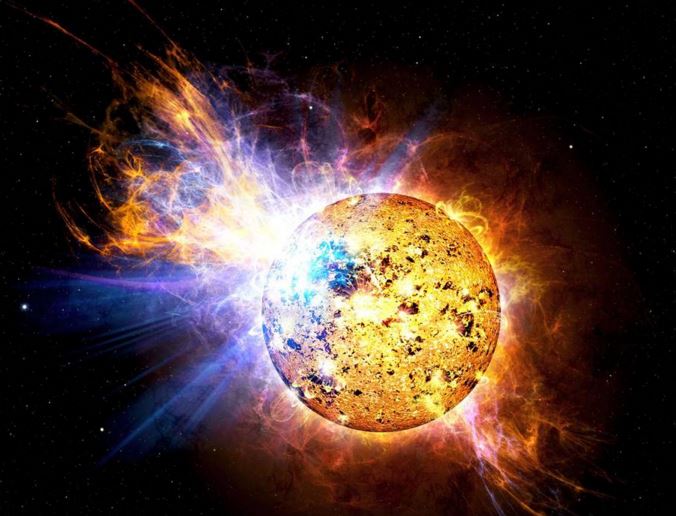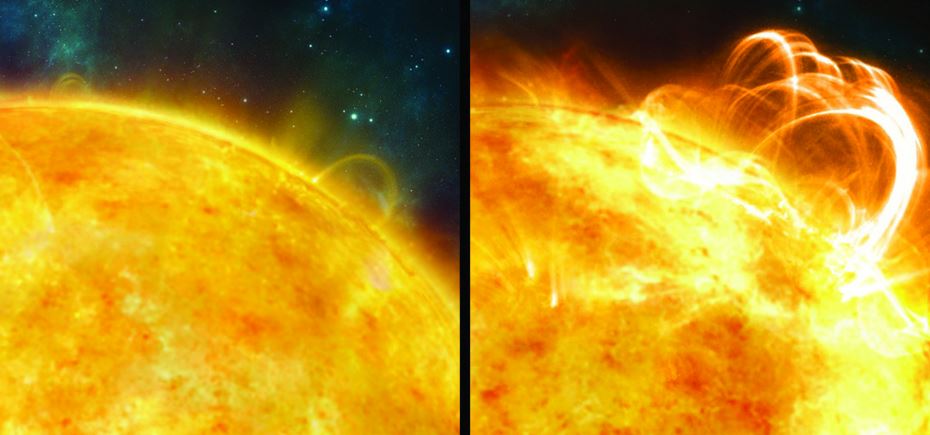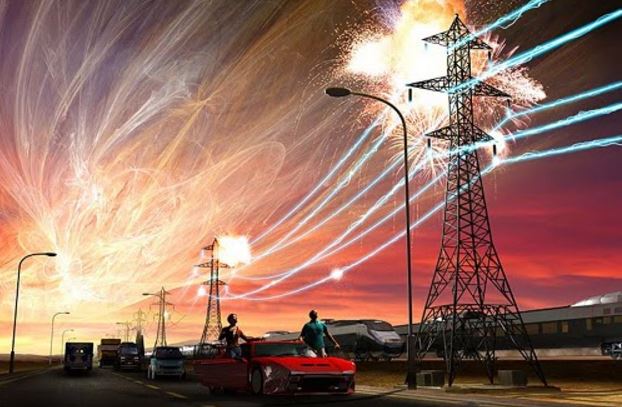A solar superflare, which is thousands of times more powerful and devastating than normal flares from the Sun, could destroy our electricity supply, GPS and communications systems, say scientists from the University of Warwick who have been analyzing a stellar superflare. Our hi-tech dependent civilization would grind to a halt.
A stellar superflare is a massive magnetic eruption in the atmosphere of a star. A mega explosion that sometimes occurs on solar-like stars with the energy-equivalent of several thousand normal flares from the Sun. Stellar means from a star, while solar means from our Sun. So, a solar superflare would be one produced by the Sun.
PhD student, Chloë Pugh, who led the study, plus colleagues at the university’s Centre for Fusion, Space and Astrophysics, wrote about a stellar superflare they studied in The Astrophysical Journal Letters.
 On April 25, 2008, NASA’s Swift satellite detected a record-setting superflare from a star known as EV Lacertae, which was thousands of times more powerful than the greatest observed solar flare. (Image: nasa.gov)
On April 25, 2008, NASA’s Swift satellite detected a record-setting superflare from a star known as EV Lacertae, which was thousands of times more powerful than the greatest observed solar flare. (Image: nasa.gov)
NASA’s Kepler space telescope had detected a stellar superflare with wave patterns very similar to those found in solar flares, the authors explained.
The superflare was detected in a binary star in the Milky Way (our galaxy) called KIC9655129, which is known to sometimes superflare. Ms. Pugh wrote that as its superflares are similar to the Sun’s flares, they both likely share the same underlying physics of flares.
Sun has the capacity to produce superflares
This means there is no reason why our Sun should not have the capacity to produce ultra-powerful superflares too.
A typical solar flare has the energy-equivalent of a 100 million megaton bomb. If our sun produced a superflare, it would have the energy equivalent of a 100 billion megaton bomb – something we do not think we have ever experienced on Earth, and would not want to (read further down about the Carrington Event).
If the sun produced a superflare, it could knock out our electricity supply, as well as our communication systems – put simply, the consequences would be catastrophic for humans.
 An artist’s depiction of the ‘quiet’ Sun (left) and with a superflare (right). (Image: University of Warwick)
An artist’s depiction of the ‘quiet’ Sun (left) and with a superflare (right). (Image: University of Warwick)
Ms. Pugh, a PhD student, said:
“Our solar system is filled with plasma, or ionised gas, originating from the Sun as a result of the solar wind and other more violent solar eruptions, such as solar flares. Stars very similar to the Sun have been observed to produce enormous flares, called superflares. To give us a better indication of whether the Sun could produce a catastrophic superflare, we need to determine whether the same physical processes are responsible for both stellar superflares and solar flares.”
“Solar flares are commonly observed to consist of a series of regularly occurring pulses. Often these pulsations resemble waves, with a wavelength that relates to various properties of the region of the Sun that is producing the flare. The study of waves such as these is referred to as coronal seismology.”
“Occasionally solar flares contain multiple waves superimposed on top of one another, which can easily be explained by coronal seismology. We have found evidence for multiple waves, or multiple periodicities, in a stellar superflare, and the properties of these waves are consistent with those that occur in solar flares.”
 Chloë Pugh is currently using data from NASA’s Kepler mission to expand the sample size of known stellar quasi-periodic pulsations, identify their periods of oscillation, and ultimately work towards modelling the flares and deducing the physical parameters of the flaring regions. (Image: University of Warwick)
Chloë Pugh is currently using data from NASA’s Kepler mission to expand the sample size of known stellar quasi-periodic pulsations, identify their periods of oscillation, and ultimately work towards modelling the flares and deducing the physical parameters of the flaring regions. (Image: University of Warwick)
Systems we depend on would stop working
If there were power blackouts across the world resulting from a solar superflare, many of our computer systems would stop working, traffic controllers at airports would not be able to guide airplanes in, airborne aircraft could lose their navigation systems and perhaps even their flight systems, traffic lights would shut down, even some systems in hospitals that rely on power and computers could fail.
Ms. Pugh added:
“Fortunately the conditions needed for a superflare are extremely unlikely to occur on the Sun, based on previous observations of solar activity.”
In this latest study, the researchers used time series analysis to detect wave patterns in the light curve of a superflare from KIC9655129, using information collected by the Kepler space telescope, a space observatory NASA launched in 2009 to discover Earth-like planets orbiting distant stars.
 A solar superflare would damage our power infrastructure considerably.
A solar superflare would damage our power infrastructure considerably.
Co-author, Dr Anne-Marie Broomhall, also from the University of Warwick, whose research focuses on solar and stellar physics, specifically helioseismology and asteroseismology, said:
“When a flare occurs we typically see a rapid increase in intensity followed by a gradual decline. Usually the decline phase is relatively smooth but occasionally there are noticeable bumps, which are termed ‘quasi-periodic pulsations’ or QPPs. We used techniques called wavelet analysis and Monte Carlo modelling in order to assess the periodicity and statistical significance of these QPPs.”
The researchers’ analysis revealed two significant periodicities, with a possibility that these pulsations would be observed by chance of less than 1%.
Dr Broomhall continued:
“We then fitted a model to the flare light curve that described both the exponential decay phase and the two periodicities. The periods were found to be 78 minutes and 32 minutes respectively. The properties of the periodicities, such as their decay times, imply that the two periodicities are independent.”
“The most plausible explanation for the presence of two independent periodicities is that the QPPs were caused by magnetohydrodynamic (MHD) oscillations, which are frequently observed in solar flares. This result is, therefore, an indication that the same physical processes are involved in both solar flares and stellar superflares. The latter finding supports the hypothesis that the Sun is able to produce a potentially devastating superflare.”
Largest solar storm on record – 1859
The largest solar storm on record occurred in 1859. It was called the Carrington Event, after Richard Carrington, a British astronomer who witnessed the huge solar flare, and was the first person to realize the link between activity on the sun and geomagnetic alterations on Earth.
Northern lights were seen as far south as Honolulu and Cuba during the Carrington Event, while southern lights were seen in Chile’s capital, Santiago.
 The flares were so powerful that it was possible to read newspaper print in the northeastern United States just from the light of the aurora. (Image: phys.hawaii.edu)
The flares were so powerful that it was possible to read newspaper print in the northeastern United States just from the light of the aurora. (Image: phys.hawaii.edu)
Telegraph operators said sparks leapt from their equipment – in some cases causing fires.
If the Carrington Event occurred today, our hi-tech infrastructure would be knocked out. The stellar superflare detected by the Kepler space telescope was much more powerful than the one that caused the Carrington Event.
National Geographic quoted Daniel Baker, of the University of Colorado’s Laboratory for Atmospheric and Space Physics, who said:
“Imagine large cities without power for a week, a month, or a year,” Baker said. “The losses could be $1 to $2 trillion, and the effects could be felt for years.”
The study was financed by a European Research Council project led by co-author Professor Valery M. Nakariakov.
Reference: C. E. Pugh, V. M. Nakariakov and A.-M. Broomhall. “A Multi-Period Oscillation in a Stellar Superflare.” The Astrophysical Journal Letters. DOI: 10.1088/2041-8205/813/1/L5.
Video – The Carrington Event 1859
